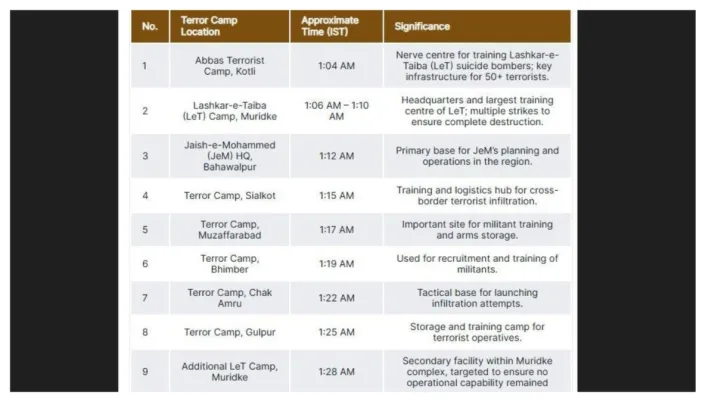Operation Sindoor, launched by Indian forces at 1:05 am on Wednesday, marked a significant escalation in India’s counter-terror strategy by targeting nine terror camps, including four in Pakistan’s Punjab province – a first for such operations.
Indian forces launched Operation Sindoor at 1:05 am on Wednesday, striking deep into Pakistan’s Punjab province for the first time in history. Unlike earlier counterstrikes in 2016 (Uri) and 2019 (Balakot), which targeted terrorist infrastructure in Pakistan-occupied Kashmir (PoK) and Khyber Pakhtunkhwa (KPK), this 25-minute operation struck nine terror camps, including four in Punjab, the political and military heartland of Pakistan.
According to Colonel Sofiya Qureshi and Wing Commander Vyomika Singh, who briefed the media on Wednesday, the strikes in Punjab were a calculated escalation, meant to deliver a decisive blow to the terror infrastructure operating with impunity within Pakistan’s core territory. One of these, the Markaz Subhan Allah camp in Bahawalpur district, lies nearly 100 km from the international border, making it one of the deepest strikes into undisputed Pakistani territory since 1971. Despite this proximity to a Pakistani Army regimental center, India has clarified that no military installations were targeted, focusing solely on terror camps.
Targets included key terror hubs
The four terror camps targeted in Pakistan’s Punjab were:
- Markaz Subhan Allah – Bahawalpur district, 100 km from the international border
- Markaz Taiba – Muridke, Sheikhupura district, 18 km from the international border
- Mehmoona Joya – Sialkot district, 18 km from the international border
- Sarjal Camp – Sialkot district, 6 km from the international border

Striking deep inside Pakistan
The operation also destroyed five additional camps in Pakistan-occupied Kashmir, significantly disrupting the terror infrastructure responsible for repeated cross-border attacks. These sites are significantly deeper inside Pakistan than the targets hit in previous strikes. For instance, the 2016 Uri surgical strikes focused on camps just across the Line of Control (LoC), while the 2019 Balakot airstrikes targeted a Jaish-e-Mohammed camp in KPK, roughly 60 km from the LoC.
Retaliation for Pahalgam attack
The strikes came in response to the April 22 Pahalgam attack, where Pakistani terrorists killed 26 civilians. Foreign Secretary Vikram Misri described the massacre as one of the deadliest in recent memory, comparing it to the 26/11 Mumbai attacks. “This was the largest number of civilian casualties in a single attack since 26/11. The attackers singled out people based on their faith, executed them in front of their families, and deliberately attempted to incite communal unrest in Jammu and Kashmir and other parts of India. The attackers even forced survivors to carry their message back to their communities,” he added.
Misri noted that Pakistan’s broader objective appeared to be to derail the return of normalcy in Kashmir, which saw a record 23 million tourists last year. He said the strikes were aimed at breaking the backbone of Pakistan’s terror apparatus.
Casualties and impact
Over 80 terrorists were reportedly killed in the strikes, significantly disrupting the terror networks behind the Pahalgam attack. Indian officials emphasised that the strikes were carefully planned to avoid civilian casualties, targeting only confirmed terror hubs.
A message to Pakistan’s power centres
Unlike the previous counter-strikes, which were limited to PoK or the tribal regions of Khyber-Pakhtunkhwa, Operation Sindoor struck at the heart of Pakistan’s Punjab – the province that hosts much of the country’s military and political power. “Punjab is where the military-industrial complex of Pakistan is deeply entrenched, including key bases and regimental centres. Striking here sends a clear message about India’s resolve to respond to terrorism at its source,” a senior defence official said.
A strategic shift in India’s retaliatory strikes
With Operation Sindoor, India has significantly expanded the geographical scope of its counterterrorism operations, signaling a new phase in its response to cross-border terrorism. This shift showcases India’s willingness to strike at the core of Pakistan’s terror infrastructure, not just in disputed regions, but within Pakistan’s heartland, delivering a clear message of deterrence.


